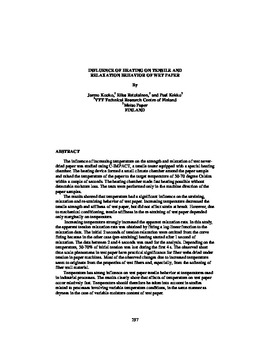| dc.contributor.author | Kouko, Jarmo | |
| dc.contributor.author | Retulainen, Elias | |
| dc.contributor.author | Kekko, Pasi | |
| dc.contributor.other | International Conference on Web Handling (2013) | |
| dc.date.accessioned | 2019-11-12T14:57:31Z | |
| dc.date.available | 2019-11-12T14:57:31Z | |
| dc.date.issued | 2013-06 | |
| dc.identifier | oksd_icwh_2013_kouko | |
| dc.identifier.citation | Kouko, J., Retulainen, E., & Kekko, P. (2013, June). Influence of heating on tensile and relaxation behavior of wet paper. Paper presented at the Twelfth International Conference on Web Handling (IWEB), Stillwater, OK. | |
| dc.identifier.uri | https://hdl.handle.net/11244/321998 | |
| dc.description.abstract | The influence of increasing temperature on the strength and relaxation of wet never-dried paper was studied using C-IMPACT, a tensile tester equipped with a special heating chamber. The heating device formed a small climate chamber around the paper sample and raised the temperature of the paper to the target temperature of 30-70 degree Celsius within a couple of seconds. The heating chamber made fast heating possible without detectable moisture loss. The tests were performed only in the machine direction of the paper samples. | |
| dc.description.abstract | The results showed that temperature had a significant influence on the straining, relaxation and re-straining behavior of wet paper. Increasing temperature decreased the tensile strength and stiffness of wet paper, but did not affect strain at break. However, due to mechanical conditioning, tensile stiffness in the re-straining of wet paper depended only marginally on temperature. | |
| dc.description.abstract | Increasing temperature strongly increased the apparent relaxation rate. In this study, the apparent tension relaxation rate was obtained by fitting a log-linear function to the relaxation data. The initial 2 seconds of tension relaxation were omitted from the curve fitting because in the other case (pre-straining) heating started after 1 second of relaxation. The data between 2 and 4 seconds was used for the analysis. Depending on the temperature, 30-70% of initial tension was lost during the first 4 s. The observed short time scale phenomena in wet paper have practical significance for fiber webs dried under tension in paper machines. Most of the observed changes due to increased temperature seem to originate from the properties of wet fibers and, especially, from the softening of fiber wall material. | |
| dc.description.abstract | Temperature has strong influence on wet paper tensile behavior at temperatures used in industrial processes. The results clearly show that effects of temperature on wet paper occur relatively fast. Temperature should therefore be taken into account in studies related to processes involving variable temperature conditions, in the same manner as dryness in the case of variable moisture content of wet paper. | |
| dc.format | application/pdf | |
| dc.language | en_US | |
| dc.publisher | Oklahoma State University | |
| dc.rights | In the Oklahoma State University Library's institutional repository this paper is made available through the open access principles and the terms of agreement/consent between the author(s) and the publisher. The permission policy on the use, reproduction or distribution of the article falls under fair use for educational, scholarship, and research purposes. Contact Digital Resources and Discovery Services at lib-dls@okstate.edu or 405-744-9161 for further information. | |
| dc.title | Influence of heating on tensile and relaxation behavior of wet paper | |
| osu.filename | oksd_icwh_2013_kouko.pdf | |
| dc.type.genre | Conference proceedings | |
| dc.type.material | Text | |
